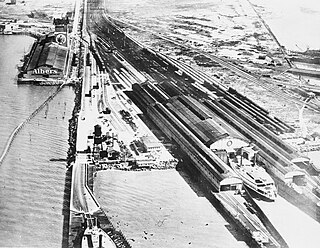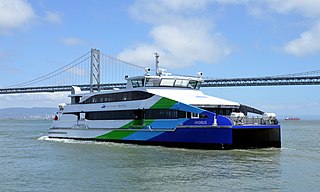
Eureka is a side-wheel paddle steamboat, built in 1890, which is now preserved at the San Francisco Maritime National Historical Park in San Francisco, California. Originally named Ukiah to commemorate the railway's recent extension into the City of Ukiah, the boat was built by the San Francisco and North Pacific Railroad Company at their Tiburon yard. Eureka has been designated a National Historic Landmark and was listed in the National Register of Historic Places on April 24, 1973.

The San Francisco Ferry Building is a terminal for ferries that travel across the San Francisco Bay, a food hall and an office building. It is located on The Embarcadero in San Francisco, California and is served by Golden Gate Ferry and San Francisco Bay Ferry routes.

Berkeley was one of several ferryboats of the Southern Pacific Railroad that for sixty years operated on San Francisco Bay between the Oakland Pier and the San Francisco Ferry Building. Built in 1898 by the Union Iron Works of San Francisco, she served after the 1906 earthquake, ferrying refugees across the bay to Oakland.

The Northwestern Pacific Railroad is a 271-mile (436 km) mainline railroad from the ferry connections in Sausalito, California north to Eureka with a connection to the national railroad system at Schellville. The railroad has gone through a history of different ownership and operators but has maintained a generic name of reference as The Northwestern Pacific Railroad, despite no longer being officially named that. Currently, only a 62-mile (100 km) stretch of mainline from Larkspur to the Sonoma County Airport in Windsor and east to Schellville on the “south end” is operated by Sonoma–Marin Area Rail Transit (SMART), which operates both commuter and freight trains with plans for future extension north to Cloverdale. The “north end” from Willits to Eureka is currently out of service, but saved by 2018 legislation to be converted into the Great Redwood Trail.

The Berkeley Pier is in Berkeley, California. When constructed in 1926, the pier extended 3.5 miles (5.6 km) into San Francisco Bay from the end of University Avenue. Due to extensive filling of the bay and the creation of the Berkeley Marina, it presently extends only 2.5 miles (4.0 km). Since 1937, only the first 3,000 feet (910 m) were maintained and open to the public until July 2015, when public access was closed due to safety concerns.

The Hyde Street Pier, at 2905 Hyde Street, is a historic ferry pier located on the northern waterfront of San Francisco in the U.S. state of California.

The Oakland Long Wharf was an 11,000-foot railroad wharf and ferry pier along the east shore of San Francisco Bay located at the foot of Seventh Street in West Oakland. The Oakland Long Wharf was built, beginning 1868, by the Central Pacific Railroad on what was previously Oakland Point. Beginning November 8, 1869, it served as the west coast terminus of the First transcontinental railroad. In the 1880s, Southern Pacific Railroad took over the CPRR, extending it and creating a new ferry terminal building with the official station name Oakland Pier. The entire structure became commonly and popularly called the Oakland Mole. Portions of the Wharf lasted until the 1960s. The site is now part of the facilities of the Port of Oakland, while passenger train service operates at the nearby Jack London Square/Dellums Station and another nearby station in Emeryville.

The North Pacific Coast Railroad (NPC) was a common carrier 3 ft (914 mm) narrow-gauge steam railroad begun in 1874 and sold in 1902 to new owners who renamed it the North Shore Railroad (California) (NSR) and which rebuilt the southern section into a standard-gauge electric railway.

The South Pacific Coast Railroad (SPC) was a 3 ft narrow gauge steam railroad running between Santa Cruz, California, and Alameda, with a ferry connection in Alameda to San Francisco. The railroad was created as the Santa Clara Valley Railroad, founded by local strawberry growers as a way to get their crops to market in San Francisco and provide an alternative to the Southern Pacific Railroad. In 1876, James Graham Fair, a Comstock Lode silver baron, bought the line and extended it into the Santa Cruz Mountains to capture the significant lumber traffic coming out of the redwood forests. The narrow-gauge line was originally laid with 52-pound-per-yard (26 kg/m) rail on 8-foot (2.44 m) redwood ties; and was later acquired by the Southern Pacific and converted to 4 ft 8+1⁄2 instandard gauge.

Blue & Gold Fleet is a privately owned company in the United States providing ferry services in the San Francisco Bay Area of California. It operates the San Francisco Bay Ferry commuter ferry system under contract with WETA. Blue & Gold also operates tourist and excursion services under its own brand from Pier 41 in San Francisco, with midday ferry service to Sausalito and a variety of tourist routes. The company is the Bay Area's largest ferry transportation provider and carries approximately 4 million passengers annually.

Golden Gate Ferry is a commuter ferry service operated by the Golden Gate Bridge, Highway and Transportation District in San Francisco Bay, part of the Bay Area of Northern California, United States. Regular service is run to the Ferry Building in San Francisco from Larkspur, Sausalito, Tiburon, and Angel Island in Marin County, with additional service from Larkspur to Oracle Park and Chase Center. The ferry service is funded primarily by passenger fares and Golden Gate Bridge tolls. In 2023, Golden Gate Ferry had a ridership of 1,299,200, or about 3,500 per weekday as of the fourth quarter of 2023.

San Francisco Bay Ferry is a public transit passenger ferry service in the San Francisco Bay, administered by the San Francisco Bay Area Water Emergency Transportation Authority (WETA) and operated under contract by the privately owned, Blue and Gold Fleet. In 2023, the system had a ridership of 2,230,400, or about 8,400 per weekday as of the fourth quarter of 2023.

The Richmond–San Rafael Ferry Company was a ferry service between Castro Point in Richmond in Contra Costa County and San Quentin in Marin County, California across the San Pablo Bay. It ran from 1915 until the 1956 opening of the Richmond–San Rafael Bridge.
The San Francisco and Oakland Railroad (SF&O) was built in 1862 to provide ferry-train service from a San Francisco ferry terminal connecting with railroad service through Oakland to San Antonio. In 1868 Central Pacific Railroad decided that Oakland would be the west coast terminus of the First transcontinental railroad and bought SF&O. Beginning November 8, 1869, part of the SF&O line served as the westernmost portion of the transcontinental railroad. It subsequently was absorbed into the Southern Pacific Railroad (SP). The track in Oakland was electrified in 1911 and extended across the San Francisco-Oakland Bay Bridge in 1939. Service was abandoned in 1941.
The San Francisco and Alameda Railroad (SF&A) was a short-lived railroad company in the East Bay area of the San Francisco Bay Area. The railroad line opened 1864–1865 from Alameda Terminal on Alameda Island to Hayward, California, with ferry service between Alameda Terminal and San Francisco started in 1864. After being bankrupted by the 1868 Hayward earthquake, it was acquired by a subsidiary of the Central Pacific Railroad in August 1869. Part of the SF&A line between Alameda Terminal and San Leandro served as a portion of the First transcontinental railroad starting in September 1869, while the southern section was abandoned in 1873.
The Western Pacific Railroad (1862–1870) was formed in 1862 to build a railroad from Sacramento, California, to the San Francisco Bay, the westernmost portion of the First transcontinental railroad. After the completion of the railroad from Sacramento to Alameda Terminal on September 6, 1869, and then the Oakland Pier on November 8, 1869, which was the Pacific coast terminus of the transcontinental railroad, the Western Pacific Railroad was absorbed in 1870 into the Central Pacific Railroad.
Sierra Nevada was a steel-hulled steam-powered passenger ferry operated on San Francisco Bay. The ferry was built for the Western Pacific Railroad as Edward T. Jeffery in 1913 and subsequently renamed Feather River. The ferry offered connecting service to San Francisco for Western Pacific train passengers arriving in Oakland, California. The ferry was sold to Southern Pacific Transportation Company when Western Pacific began using Southern Pacific's Oakland ferry facilities in May, 1933. Southern Pacific renamed the ferry Sierra Nevada and placed it in commuter service between San Francisco and Alameda, California until that route was discontinued in 1939. The ferry was leased to the Key System for the Golden Gate International Exposition on Treasure Island from 1939 through 1940. In 1942, the ferry was requisitioned by the federal government to carry shipyard workers from San Francisco to Richmond Yard 1 through World War II. The Richmond-San Rafael Ferry Company purchased the ferry in 1947 and rebuilt it to carry automobiles between Richmond and San Rafael until the Richmond–San Rafael Bridge opened on 1 September 1956. The ferry was then towed to San Pedro, Los Angeles where she sank in 1978.

The South San Francisco Ferry Terminal is the only operating ferry terminal in San Mateo County, California. Boats are operated there by the San Francisco Bay Ferry company, and connect the city of South San Francisco to the Oakland Ferry Terminal in Jack London Square as well as Alameda, California.

Sausalito Ferry Terminal is a ferry terminal in Sausalito, California, connecting Marin County and San Francisco. The station is served by Golden Gate Ferry and Blue & Gold Fleet ferries as well as Golden Gate Transit and Marin Transit bus routes.
Golden Gate Ferry Company was a private company which operated automobile ferries between San Francisco, Berkeley and Sausalito before the opening of the Bay Bridge and the Golden Gate Bridge. The company was incorporated in November 1920. In early 1929, the Golden Gate Ferry Company merged with the ferry system of the Southern Pacific railroad, becoming the Southern Pacific-Golden Gate Ferries, Ltd. The auto ferries were discontinued soon after the Golden Gate and Bay Bridges were opened.
























